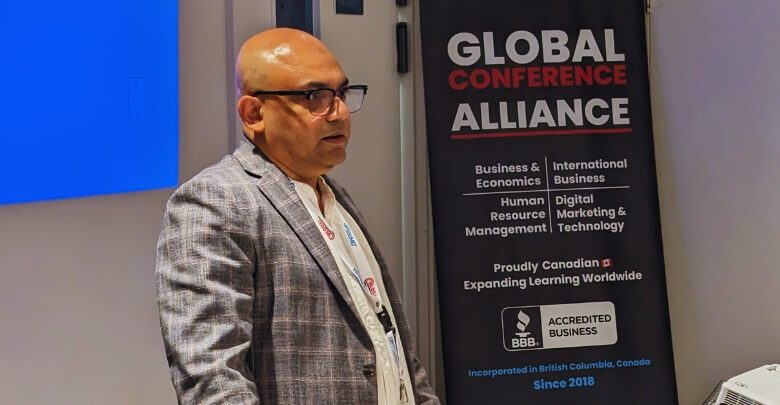In today’s world, every public appearance can leave a lasting impression, impacting your brand’s perception. Recognize a pain point we’ve all observed: keynote speakers who don’t resonate with their audience because their attire distracts or fails to represent their message.
So, what to wear as a keynote speaker?
The solution lies in understanding that your attire is an extension of your personal brand. “Dress to Express” is not just a mantra; it’s a strategy. Take note of iconic speakers who consistently wear signature colors like red, orange, hot pink, or even stark black.
These aren’t mere fashion choices; they’re a crucial part of their brand’s image. And if you’re into humor, those bright, colorful jackets aren’t just for laughs; they cement a memorable identity. The right attire aligns with and enhances your message, ensuring that your audience remembers not just your words but the whole package.
The Purpose of a Keynote Speaker
Keynote speaking plays a pivotal role in setting the tone of an event and shaping its central theme and message. Conferences and events hinge on the keynote’s energy and direction.
A keynote speaker’s primary role is to introduce the overarching theme, capturing attendees’ attention and focus. Their message becomes the touchstone, resonating throughout the event. While the opening is crucial, sustaining interest is equally vital.
An adept keynote doesn’t merely introduce but engages, inspiring thought and discussion. Through compelling stories and insights, they ensure the audience stays hooked, making more profound understanding and connection.
Beyond setting themes and maintaining interest, keynotes act as the event’s compass. They guide the discourse, steer debates, and highlight pressing issues, ensuring the event remains centered around its core objectives. To keep an event relevant and focused, it is important to attend conferences where top-notch keynote speakers perform.
The Importance of Appropriate Dress
Appropriate attire isn’t just about fashion; it’s a statement of context, intention, and respect.
Dressing correctly conveys understanding and appreciation of a setting. Whether it’s a business meeting or a casual gathering, clothes signify respect for the occasion. They silently communicate one’s seriousness and commitment.
First impressions, often cemented within seconds, hinge largely on appearance. A well-chosen outfit can open doors, creating trust and approachability. Conversely, unsuitable attire can hinder opportunities and create unintentional barriers.
Clothing choices also influence our self-perception and confidence. Donning appropriate dress not only impresses others but also boosts one’s self-esteem. Feeling good internally often starts with looking good externally.
Types of Events
Managing the vast landscape of events requires understanding their distinct characteristics and target audiences.
Corporate Events:
In corporate settings, professionalism and formality often take precedence. Attendees typically come from structured business backgrounds, expecting detailed presentations and polished dialogues. Networking plays a pivotal role, with many seeking to create professional ties and alliances.
Evolving industry trends, financial projections, and leadership strategies frequently dominate the discussions. Such events prioritize enhancing business knowledge, showcasing industry advancements, and facilitating peer-to-peer connections. The audience often looks for takeaways that directly benefit their professional growth.
Tech Industry Events:
These events showcase the latest in technological advancements and innovations. Enthusiasts, developers, and industry leaders gather to explore future tech trajectories. Panels often dive deep into tech nuances, making a space for detailed technical discourse.
It’s not just about showcasing technology; it’s about predicting the future. Attendees seek insights on upcoming trends, breakthroughs, and potential industry shifts. Networking focuses on collaboration and innovation, with many looking for the next big idea.
Creative or Artsy Events:
Artistic events offer a platform for creators to showcase their talents. These events celebrate individual expression, innovation, and boundary-pushing ideas. They often have a relaxed yet vibrant atmosphere, promoting creativity and exploration.
Workshops, exhibitions, and interactive sessions define these gatherings. Attendees are encouraged to participate, collaborate, and immerse themselves in the art. The focus is on inspiration, connection, and celebration of the creative spirit.
Mixed Audience Events:
Tailored to a diverse audience, these events blend various elements. They cater to professionals, creatives, tech enthusiasts, and more, ensuring broad appeal. Topics and activities are designed to engage different interest groups, striking a balance.
While diversity enriches these events, planning them requires careful orchestration. Ensuring that each segment of the audience is catered to is paramount. Content, speakers, and activities must offer something for everyone, creating a harmonious blend.
Types of Dress Codes to Consider
Dress codes provide guidelines for attire, ensuring consistency and appropriateness for various settings. Understanding them is crucial to making a fitting impression.
Business Casual:
Business casual strikes a balance between relaxed and professional attire. It offers flexibility, allowing individuals to express personality while maintaining a businesslike appearance. This dress code often includes khakis, polos, or blouses.
It’s the go-to attire for modern workplaces that value comfort without compromising on professionalism. Men might opt for button-down shirts; women might choose tailored skirts or trousers. The aim is polished yet approachable elegance.
Business Professional:
Reserved for traditional corporate settings, business professionals demand sharp, formal attire. Think of well-fitted suits, ties, and polished shoes for men, with women donning suits or conservative dresses. The look prioritizes precision, indicating seriousness and commitment.
Colors usually lean toward neutral shades: blacks, navies, and grays. Accessories, while allowed, are kept minimal and sophisticated. The ensemble radiates confidence, readiness, and authority.
Dress Rehearsal (Semi-Formal):
Dress rehearsal, or semi-formal attire, bridges the gap between casual wear and black-tie events. Men might opt for a dark business suit, while women can explore cocktail dresses. The look is refined yet not overly opulent.
These events, often evening affairs, require a touch of glamour. While the attire is less rigid than formal events, elegance is key. It’s about showcasing sophistication with a hint of personal flair.
What to Wear as a Keynote Speaker?
As a keynote speaker, your attire speaks volumes before you utter a word. Dressing the part reinforces your message and credibility, setting the stage for the purpose of the keynote speech even before you step onto the platform.
Recognizing the Audience:
Understanding your audience lays the foundation for attire choices. Corporate gatherings might demand business professionals, while tech events lean towards casual. Wear what aligns with their expectations, ensuring relatability and rapport.
Expressing Authenticity:
Your attire should reflect authenticity and complement your personal brand. Choose colors and styles that resonate with your message and persona. Consistency in your look helps in establishing a memorable brand identity.
Comfort and Confidence:
While appearance matters, comfort is paramount. An uncomfortable outfit can distract, and undermine your delivery and poise. Wear what boosts confidence, ensuring you remain focused and impactful.
Final Thoughts
In the vast world of public speaking, an often overlooked pain point emerges: the challenge of choosing the proper attire. So, when pondering what to wear as a keynote speaker?
It’s imperative to remember the influence of first impressions. The right dress augments your message and solidifies your position as an authority. Aligning your attire with your audience, expressing genuine authenticity, and ensuring comfort can make a world of difference.
By making mindful clothing choices, speakers can ensure that their audience remembers not only the essence of their speech but also the confidence and credibility with which it was delivered. Embrace your wardrobe as an essential tool in your speaker’s toolkit.








